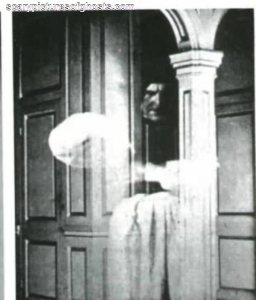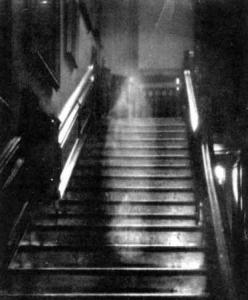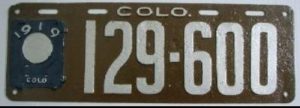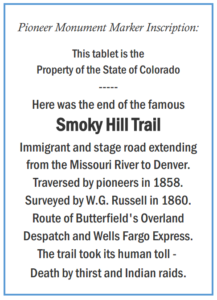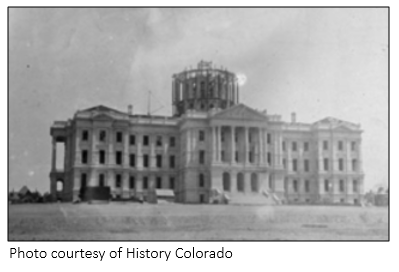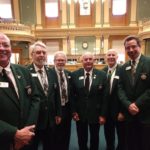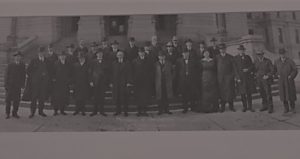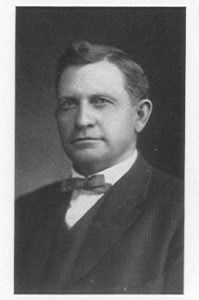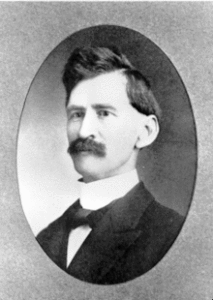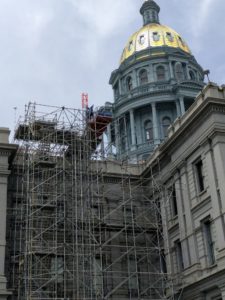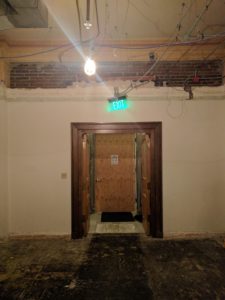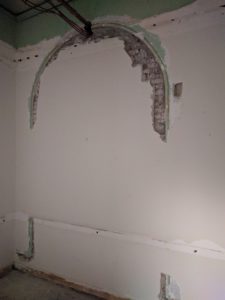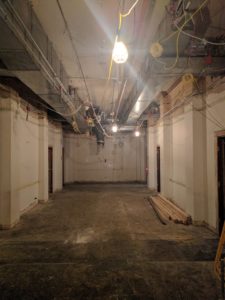by Patti Dahlberg
The First World War was over but for many, the post-war world was perilous. The Bolshevik Revolution in Russia, which started during the war as a workers’ revolution and a protest against Russia’s involvement in the war, evolved into civil war ending with the violent overthrow of the Russian government and the establishment of a communist dictatorship. It should not be surprising that, as numerous post-war workers’ strikes throughout Europe and even in the United States became increasingly associated with violence, Americans’ fear of anarchy and communism amplified accordingly.
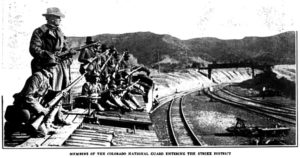 Social tensions throughout the world had been growing and, at times, erupting into violence for several decades. America had witnessed several fatal outcomes from labor conflicts, including the 1886 Haymarket bombing in Chicago and a bloody battle between Pinkerton agents and steel workers at the Homestead Steel Works in Pennsylvania. In Colorado, altercations during the 1913-14 Colorado Coal Wars became increasingly violent, resulting in the Ludlow Massacre on April 20, 1914, when the Colorado National Guard fired machine guns into a colony of 1,200 striking coal miners and their families and fire swept through the strikers’ tent city. Twenty men, women, and children were killed with many more injured. The ensuing retaliation assured continued confrontations and casualties after the massacre. Somewhere between 70 and 200 people were killed during Colorado’s Coal War. During the 1919 legislative session, Colorado was still dealing with the aftermath of the Ludlow tragedy as legislators appropriated funds for House Bill No. 311 “Commission for Investigation of Italian Government Claims” regarding the “alleged loss of lives, and destruction of property of certain Italian subjects during the strike of Coal Miners in Colorado in the year 1914.”
Social tensions throughout the world had been growing and, at times, erupting into violence for several decades. America had witnessed several fatal outcomes from labor conflicts, including the 1886 Haymarket bombing in Chicago and a bloody battle between Pinkerton agents and steel workers at the Homestead Steel Works in Pennsylvania. In Colorado, altercations during the 1913-14 Colorado Coal Wars became increasingly violent, resulting in the Ludlow Massacre on April 20, 1914, when the Colorado National Guard fired machine guns into a colony of 1,200 striking coal miners and their families and fire swept through the strikers’ tent city. Twenty men, women, and children were killed with many more injured. The ensuing retaliation assured continued confrontations and casualties after the massacre. Somewhere between 70 and 200 people were killed during Colorado’s Coal War. During the 1919 legislative session, Colorado was still dealing with the aftermath of the Ludlow tragedy as legislators appropriated funds for House Bill No. 311 “Commission for Investigation of Italian Government Claims” regarding the “alleged loss of lives, and destruction of property of certain Italian subjects during the strike of Coal Miners in Colorado in the year 1914.”
Organized labor had grown in strength during the course of the war. The labor movement helped abolish the 12-hour workday when 8-hour days were instituted on war contract work. By 1919, half of the country’s workers had a 48-hour work week. Normal work weeks remained at six days, although the 1919 Colorado General Assembly did pass Senate Bill No. 92 “Holidays – When and Where Saturday Afternoon is a Holiday” to designate Saturday afternoons in June, July, and August as holidays. High wartime inflation, with food prices doubling and clothing costs more than tripling between 1915 and 1920, further aggravated ongoing labor disputes. More than four million workers—one fifth of the nation’s workforce—participated in strikes in 1919, including 365,000 steelworkers and 400,000 miners. This quantity of striking workers would not be seen again until 1937—during the Great Depression.
Some Notable Strikes
Worker strikes in America became more than simple disputes between labor and management and, rightly or wrongly, became tinged with red and therefore a focal point for growing fears of anarchy and communism. For six days in February, the first “general strike” in American history occurred when thousands of Seattle workers joined shipyard workers in their strike for higher wages. The war made Seattle a union city; there were unions for shipyard workers, longshoremen, streetcar motormen, conductors, butchers, waitresses, laundry women, housemaids, barbers, and even newsboys. By the war’s end, Seattle had 110 unions representing about 60,000 union members, and almost all of them agreed to the sympathy strike. The “Seattle General Strike” lasted from

February 6 to February 11, 1919, For two of those days Seattle’s streets were completely still as union members stayed home in solidarity with the striking ship workers. Although the strike was completely peaceful, it was condemned as a communist (“red”) threat to American freedoms. Coverage of the strike often shared page-one headlines with news of communist military activity in Europe.
On September 9, 1919, more than 1,100 or roughly 80% of Boston’s police force went on strike to protest the opposition to its attempt to organize a union and to seek improved wages and working conditions. New hire pay had not risen in 60 years, and officers worked 73 to 98 hours, seven days a week with one day off every other week. The strike left Boston streets unsupervised and led to several days of civil unrest, rioting, looting, and property damage. Governor Calvin Coolidge called in the Massachusetts State Guard to restore order by force. Nine were killed during the strike and more than 20 were seriously wounded. Striking workers were called “deserters” and “agents of Lenin.” The strike ended on September 13, and the State Guard remained in charge until mid-December, when all of the striking police officers had been replaced with new workers who received higher wages and better working conditions.
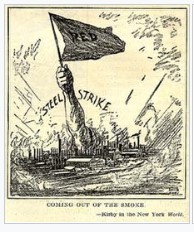 The largest American strike occurred among steel workers in the Midwest from September 1919 to January 1920. Known as the “Great Steel Strike of 1919,” it shut down half the steel industry, including mills in Pueblo, Colorado. The strike eventually involved more than 350,000 workers in 24 separate unions. Workers demanded higher wages, an eight-hour workday, and recognition of their unions. Company owners portrayed the workers as dangerous radicals who threatened the American way of life, preying on social fears of communism. Because many of the striking workers were recent immigrants, owners were able to portray them as foreign instigators of trouble. Government officials used National Guard troops and federal troops to quell strikes in many cities. Eighteen strikers were killed, hundreds seriously injured, and thousands jailed over the course of the strike. At a time when communists were seizing power in Hungary and staging a revolt in Germany and workers in Italy were seizing factories, some industrialists feared that the steel strike was the first step toward overturning the American industrial system.
The largest American strike occurred among steel workers in the Midwest from September 1919 to January 1920. Known as the “Great Steel Strike of 1919,” it shut down half the steel industry, including mills in Pueblo, Colorado. The strike eventually involved more than 350,000 workers in 24 separate unions. Workers demanded higher wages, an eight-hour workday, and recognition of their unions. Company owners portrayed the workers as dangerous radicals who threatened the American way of life, preying on social fears of communism. Because many of the striking workers were recent immigrants, owners were able to portray them as foreign instigators of trouble. Government officials used National Guard troops and federal troops to quell strikes in many cities. Eighteen strikers were killed, hundreds seriously injured, and thousands jailed over the course of the strike. At a time when communists were seizing power in Hungary and staging a revolt in Germany and workers in Italy were seizing factories, some industrialists feared that the steel strike was the first step toward overturning the American industrial system.
Sources:
http://www.ohiohistorycentral.org/w/Great_Steel_Strike_of_1919
https://www.gilderlehrman.org/content/historical-context-post-world-war-i-labor-tensions
https://encyclopedia.1914-1918-online.net/article/labour_movements_trade_unions_and_strikes_usa

